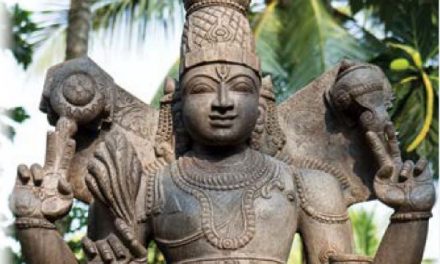 The Fire of Life
The Fire of Life
by Dr. P.R. Vishnu, BAMS, MD
The manifestation of the fire element in the body is known as Agni (digestive fire) in Ayurveda. Agni is the faculty which is responsible for the process of transformation and assimilation of food consumed.
 Agni converts food into energy, which is responsible for all the vital functions of our body. Therefore, Ayurveda considers that Agni is the cause of life. Ayurveda stresses that Agni is to be nurtured. Once the functions of Agni are vitiated, the body produces Ama (a metabolic toxicity) which leads to disease. Acharya Charaka, considered to be the father of Ayurveda, tells us that the presence of Agni in normalcy is life and its destruction within the body is death.
Agni converts food into energy, which is responsible for all the vital functions of our body. Therefore, Ayurveda considers that Agni is the cause of life. Ayurveda stresses that Agni is to be nurtured. Once the functions of Agni are vitiated, the body produces Ama (a metabolic toxicity) which leads to disease. Acharya Charaka, considered to be the father of Ayurveda, tells us that the presence of Agni in normalcy is life and its destruction within the body is death.
According to Ayurveda the functions of Agni include the digestion of food; nourishment of the doshas (humors); nourishment of the dhatus (tissues); creation of immunity; clarity of mind; and maintenance of the life force. There are thirteen types of Agni in the body. Of these the principle ones are:
JATHARAGNI (Abdominal Fire, 1), the primary Agni located in the abdomen (the digestive tract) which nourishes the other Agnis. It is responsible for the entire process of digestion of food materials in the gastro-intestinal tract leading to the production and absorption of nutrients as well as the formation and elimination of waste products such as urine, faeces etc.
BHUTAGNI (Elemental Fire, 5) is located in the liver and is responsible for breaking down the nutrients into the five elements which are required for maintenance and growth in the body and for the transformation of the five elements into the seven tissues (dhatus). Bhutagni transforms the heterogeneous nutrients into one homogenous substance which can be accepted into the structure of body and starts its work immediately after the absorption of nutrients. The food molecules are circulated by Bhutagni throughout the body for nourishing the seven dhatus.
DHATUAGNI (Tissue Fire, 7) is responsible for the absorption of tissue-specific nutrients and goes to work after Jathragni and Bhutagni. Each Dhatuagni is located in its specific tissue to permit its nutrients from the circulating substances derived after Bhutagni to form its own tissues.
These thirteen types of Agni can be categorised into four states depending on dosha dominance.
Mandagni (hypo-functioning)—Hypo-secretion of digestive enzymes —a state in which Agni is considerably inhibited due to the dominance of kapha. Agni is unable to digest and metabolise even a small quantity of easily-digested food leading to indigestion, low appetite and food intolerance.
Tikshnagni (hyper-functioning)—Hyper-secretion of digestive enzymes—a state in which pitta is in dominance. The Agni in this condition is said to be excessively excited and will digest even a very heavy meal easily and in a very short span of time. It can cause voracious hunger and discomfort of heat in the throat, palate and lips, as well as heartburn.
Vishamagni (irregular functioning)—Irregular secretion of digestive enzymes—a state in which vata is in dominance. The Agni in this condition is erratic and fitful, sometimes helping in the process of complete digestion and at other times producing distention of the abdomen, colic, constipation, dysentery, IBS and loose motions.
Samagni—(normal functioning)—Normal secretion of digestive enzymes—a well-equilibrated state of the functioning of the tridoshas. The Agni in this condition digests the food at the scheduled time without giving rise to disharmony in the body, conserves body energy and is conducive to good health.
PROPER AGNI FUNCTION
When Agni is functioning as it should the following are observed
• Adequate diet
• Timely evacuation of bowel and bladder
• Good strength
• Good resistance to infection (immunity)
• Good skin lustre
• Proper functioning of all sensory organs
POOR AGNI FUNCTION
The symptoms of mild to moderate malfunctioning of Agni are as follows
• Loss of appetite
• Lethargy
• Recurrent infection
• Constipation/diarrhoea
• Incomplete evacuation of bladder or difficulty in micturition
• Improper functioning of sense organs
• Depression
The symptoms of severe malfunctioning of Agni are as follows
• Collection of fluid in the body (ascites, oedema, pleural effusion, pericardial effusion etc.)
• Marked loss of energy and general debility
• Loss of enthusiasm
• Improper sleep
Yoga and Agni
- Asana practice purifies and balances the digestive fire (Jatharagni).
- Pranayama purifies, balances and energizes the pranic or breath fire (Pranagni).
- Pratyahara or internalisation purifies and internalises the fire of the sense and motor organs (Indriya-agni), particularly that of the eye and speech, the main forms of Agni in the sense and motor organs.
- Dharana or concentration focuses and heightens the fire of the mind (Manasa-agni).
- Dhyana or meditation increases the fire of wisdom (Buddhi-agni).
- Samadhi or absorption merges us into the Divine fire to transform our consciousness at a soul level (Jiva-agni).
Keep the fire of life burning through the practice of yoga!!
Dr P.R. Vishnu, BAMS, MD is director of the Sivananda Institute of Health at the Sivananda Dhanwantari Ashram, Kerala, south India, e-mail: [email protected]































